Matching Relationship between Urban Service Industry Land Expansion and Economy Growth in China
Abstract
1. Introduction
1.1. Background
1.2. Literature Review
1.2.1. Service Industry Land Use
1.2.2. Decoupling of Economic Growth
1.3. Aim and Question
2. Research Design
2.1. Study Area: China
2.2. Technical Roadmap and Research Methods
2.2.1. Research Steps
2.2.2. Exploratory Spatial Data Analysis and Spatial Clustering Analysis
2.2.3. Decoupling Model
2.2.4. GeoDetector
2.2.5. Data Sources
3. Results
3.1. Dynamic Analysis
3.1.1. Spatial Heterogeneity
3.1.2. Spatial Autocorrelation
3.2. Decoupling Analysis
3.2.1. Service Industry
3.2.2. Urban Economy
3.2.3. Government Revenue
3.3. Influence Factors
3.3.1. Direct Driving Force
3.3.2. Interactive Driving Force
4. Discussion
4.1. Design and Implement Differentiated Management Zones in Response to Spatial Effects
4.2. Design and Implement Intensive Development Policies in Response to Decoupling Effects
5. Conclusions
Author Contributions
Funding
Data Availability Statement
Conflicts of Interest
References
- Lee, J.-W.; McKibbin, W.J. Service sector productivity and economic growth in Asia. Econ. Model. 2018, 74, 247–263. [Google Scholar] [CrossRef]
- David, A.H. A service sector classification scheme using economic data. Serv. Ind. J. 2014, 34, 335–353. [Google Scholar] [CrossRef]
- Eichengreen, B.; Gupta, P. The two waves of service-sector growth. Oxf. Econ. Pap. 2013, 65, 96–123. [Google Scholar] [CrossRef]
- Li, Y.; Yuan, F. Business-promoted city-regionalism? New Industrial City projects by China Fortune Land Development. Reg. Stud. 2021, 56, 355–370. [Google Scholar] [CrossRef]
- Borel-Saladin, J.; Crankshaw, O. Social Polarisation or Professionalisation? Another Look at Theory and Evidence on Deindustrialisation and the Rise of the Service Sector. Urban Stud. 2009, 46, 645–664. [Google Scholar] [CrossRef]
- Meyssonnier, F. Service industry management control: A reflexion about its essence and tools. Comptab. Controle Audit. 2012, 18, 73–97. [Google Scholar] [CrossRef]
- González-Cruz, T.F.; Roig-Tierno, N.; Botella-Carrubí, D. Quality management as a driver of innovation in the service industry. Serv. Bus. 2018, 12, 505–524. [Google Scholar] [CrossRef]
- Gupta, S. Decoupling: A step toward sustainable development with reference to OECD countries. Int. J. Sustain. Dev. World Ecol. 2015, 22, 510–519. [Google Scholar] [CrossRef]
- Guo, S.; Liu, L.; Zhao, Y. The business cycle implications of land financing in China. Econ. Model. 2015, 46, 225–237. [Google Scholar] [CrossRef]
- Liao, J. The rise of the service sector in China. China Econ. Rev. 2020, 59, 101385. [Google Scholar] [CrossRef]
- Wang, L.; Yuan, F.; Duan, X. How high-speed rail service development influenced commercial land market dynamics: A case study of Jiangsu province, China. J. Transp. Geogr. 2018, 72, 248–257. [Google Scholar] [CrossRef]
- Shao, S.; Tian, Z.; Yang, L. High speed rail and urban service industry agglomeration: Evidence from China’s Yangtze River Delta region. J. Transp. Geogr. 2017, 64, 174–183. [Google Scholar] [CrossRef]
- Tian, M.; Li, T.; Yang, S.; Wang, Y.; Fu, S. The Impact of High-Speed Rail on the Service-Sector Agglomeration in China. Sustainability 2019, 11, 2128. [Google Scholar] [CrossRef]
- Tian, M.; Li, T.; Ye, X.; Zhao, H.; Meng, X. The impact of high-speed rail on service industry agglomeration in peripheral cities. Transp. Res. Part D Transp. Environ. 2021, 93, 102745. [Google Scholar] [CrossRef]
- Yang, L.Y.; Hu, L.Q.; Shang, P.; Ye, Y.M. Estimating the Impacts of High-speed Rail on Service Industry Agglomeration in China. J. Transp. Econ. Policy 2021, 55, 16–35. [Google Scholar]
- Sheng, J.; Xu, H.; Zheng, J.; Luo, M.; Zhou, X. Commercial Value Assessment of “Grey Space” under Overpasses: Analytic Hierarchy Process. Adv. Civ. Eng. 2018, 2018, 4970697. [Google Scholar] [CrossRef]
- Yang, H.J.; Song, J.; Choi, M.J. Measuring the Externality Effects of Commercial Land Use on Residential Land Value: A Case Study of Seoul. Sustainability 2016, 8, 432. [Google Scholar] [CrossRef]
- Sohn, D.-W. Do all commercial land uses deteriorate neighborhood safety?: Examining the relationship between commercial land-use mix and residential burglary. Habitat Int. 2016, 55, 148–158. [Google Scholar] [CrossRef]
- Browning, C.R.; Byron, R.A.; Calder, C.A.; Krivo, L.J.; Kwan, M.-P.; Lee, J.-Y.; Peterson, R.D. Commercial Density, Residential Concentration, and Crime: Land Use Patterns and Violence in Neighborhood Context. J. Res. Crime Delinq. 2010, 47, 329–357. [Google Scholar] [CrossRef]
- Izanloo, A.; Rafsanjani, A.K.; Ebrahimi, S.P. Effect of Commercial Land Use and Accessibility Factor on Traffic Flow in Bojnourd. J. Urban Plan. Dev. 2017, 143, 05016016. [Google Scholar] [CrossRef]
- Langer, S.; Korzhenevych, A. The effect of industrial and commercial land consumption on municipal tax revenue: Evidence from Bavaria. Land Use Policy 2018, 77, 279–287. [Google Scholar] [CrossRef]
- Nichols, J.B.; Oliner, S.D.; Mulhall, M.R. Swings in commercial and residential land prices in the United States. J. Urban Econ. 2013, 73, 57–76. [Google Scholar] [CrossRef]
- Garang, Z.; Wu, C.; Li, G.; Zhuo, Y.; Xu, Z. Spatio-Temporal Non-Stationarity and Its Influencing Factors of Commercial Land Price: A Case Study of Hangzhou, China. Land 2021, 10, 317. [Google Scholar] [CrossRef]
- Ustaoglu, E.; Silva, F.B.E.; LaValle, C. Quantifying and modelling industrial and commercial land-use demand in France. Environ. Dev. Sustain. 2020, 22, 519–549. [Google Scholar] [CrossRef]
- Silva, F.B.E.; Koomen, E.; Diogo, V.; Lavalle, C. Estimating Demand for Industrial and Commercial Land Use Given Economic Forecasts. PLoS ONE 2014, 9, e91991. [Google Scholar] [CrossRef]
- Wiedenhofer, D.; Virág, D.; Kalt, G.; Plank, B.; Streeck, J.; Pichler, M.; Mayer, A.; Krausmann, F.P.; Brockway, P.; Schaffartzik, A.; et al. A systematic review of the evidence on decoupling of GDP, resource use and GHG emissions, part I: Bibliometric and conceptual mapping. Environ. Res. Lett. 2020, 15, 063002. [Google Scholar] [CrossRef]
- Haberl, H.; Wiedenhofer, D.; Virág, D.; Kalt, G.; Plank, B.; Brockway, P.; Fishman, T.; Hausknost, D.; Krausmann, F.; Leon-Gruchalski, B.; et al. A systematic review of the evidence on decoupling of GDP, resource use and GHG emissions, part II: Synthesizing the insights. Environ. Res. Lett. 2020, 15, 065003. [Google Scholar] [CrossRef]
- Wang, T.; Riti, J.S.; Shu, Y. Decoupling emissions of greenhouse gas, urbanization, energy and income: Analysis from the economy of China. Environ. Sci. Pollut. Res. 2018, 25, 19845–19858. [Google Scholar] [CrossRef]
- Frodyma, K.; Papież, M.; Śmiech, S. Decoupling Economic Growth from Fossil Fuel Use—Evidence from 141 Countries in the 25-Year Perspective. Energies 2020, 13, 6671. [Google Scholar] [CrossRef]
- Yasmeen, H.; Tan, Q. Assessing Pakistan’s energy use, environmental degradation, and economic progress based on Tapio decoupling model. Environ. Sci. Pollut. Res. 2021, 28, 68364–68378. [Google Scholar] [CrossRef]
- Szigeti, C.; Toth, G.; Szabo, D.R. Decoupling—shifts in ecological footprint intensity of nations in the last decade. Ecol. Indic. 2017, 72, 111–117. [Google Scholar] [CrossRef]
- Dong, F.; Li, J.; Zhang, X.; Zhu, J. Decoupling relationship between haze pollution and economic growth: A new decoupling index. Ecol. Indic. 2021, 129, 107859. [Google Scholar] [CrossRef]
- Dong, F.; Li, J.; Li, K.; Sun, Z.; Yu, B.; Wang, Y.; Zhang, S. Causal chain of haze decoupling efforts and its action mechanism: Evidence from 30 provinces in China. J. Clean. Prod. 2020, 245, 118889. [Google Scholar] [CrossRef]
- Qian, Y.; Cao, H.; Huang, S. Decoupling and decomposition analysis of industrial sulfur dioxide emissions from the industrial economy in 30 Chinese provinces. J. Environ. Manag. 2020, 260, 110142. [Google Scholar] [CrossRef]
- Chen, J.; Wang, P.; Cui, L.; Huang, S.; Song, M. Decomposition and decoupling analysis of CO2 emissions in OECD. Appl. Energy 2018, 231, 937–950. [Google Scholar] [CrossRef]
- Mikayilov, J.I.; Hasanov, F.J.; Galeotti, M. Decoupling of CO2 emissions and GDP: A time-varying cointegration approach. Ecol. Indic. 2018, 95, 615–628. [Google Scholar] [CrossRef]
- Adalibieke, W.; Zhan, X.; Cui, X.; Reis, S.; Winiwarter, W.; Zhou, F. Decoupling between ammonia emission and crop production in China due to policy interventions. Glob. Chang. Biol. 2021, 27, 5877–5888. [Google Scholar] [CrossRef]
- Lundquist, S. Explaining events of strong decoupling from CO2 and NOx emissions in the OECD 1994–2016. Sci. Total. Environ. 2021, 793, 148390. [Google Scholar] [CrossRef]
- Shi, Y.B.; Zhao, X.X.; Jang, C.-L.; Chang, C.-P. Decoupling effect between economic development and environmental pollution: A spatial-temporal investigation using 31 provinces in China. Energy Environ. 2019, 30, 755–775. [Google Scholar] [CrossRef]
- Chen, X.; Pang, J.; Zhang, Z.; Li, H. Sustainability Assessment of Solid Waste Management in China: A Decoupling and Decomposition Analysis. Sustainability 2014, 6, 9268–9281. [Google Scholar] [CrossRef]
- Wang, L.; Cutforth, H.; Lal, R.; Chai, Q.; Zhao, C.; Gan, Y.; Siddique, K.H. ‘Decoupling’ land productivity and greenhouse gas footprints: A review. Land Degrad. Dev. 2018, 29, 4348–4361. [Google Scholar] [CrossRef]
- Zhang, Z.; Hu, B.; Shi, K.; Su, K.; Yang, Q. Exploring the dynamic, forecast and decoupling effect of land natural capital utilization in the hinterland of the Three Gorges Reservoir area, China. Sci. Total. Environ. 2020, 718, 134832. [Google Scholar] [CrossRef] [PubMed]
- Shao, J.; Ge, J. Investigation into Relationship between Intensive Land Use and Urban Heat Island Effect in Shijiazhuang City Based on the Tapio Decoupling Theory. J. Urban Plan. Dev. 2020, 146, 04020043. [Google Scholar] [CrossRef]
- Li, Y.-N.; Cai, M.; Wu, K.; Wei, J. Decoupling analysis of carbon emission from construction land in Shanghai. J. Clean. Prod. 2019, 210, 25–34. [Google Scholar] [CrossRef]
- Li, M.; Shi, Y.; Duan, W.; Chen, A.; Wang, N.; Hao, J. Spatiotemporal Decoupling of Population, Economy and Construction Land Changes in Hebei Province. Sustainability 2019, 11, 6794. [Google Scholar] [CrossRef]
- Wang, C.; Liu, Y.; Kong, X.; Li, J. Spatiotemporal Decoupling between Population and Construction Land in Urban and Rural Hubei Province. Sustainability 2017, 9, 1258. [Google Scholar] [CrossRef]
- Liu, Y.; Cai, E.; Jing, Y.; Gong, J.; Wang, Z. Analyzing the Decoupling between Rural-to-Urban Migrants and Urban Land Expansion in Hubei Province, China. Sustainability 2018, 10, 345. [Google Scholar] [CrossRef]
- Guo, S.; Wang, Y.; Huang, J.; Dong, J.; Zhang, J. Decoupling and Decomposition Analysis of Land Natural Capital Utilization and Economic Growth: A Case Study in Ningxia Hui Autonomous Region, China. Int. J. Environ. Res. Public Health 2021, 18, 646. [Google Scholar] [CrossRef]
- Imbrogiano, J.-P. Contingency in Business Sustainability Research and in the Sustainability Service Industry: A Problematization and Research Agenda. Organ. Environ. 2020, 34, 298–322. [Google Scholar] [CrossRef]
- Zhang, P.; Li, W.; Zhao, K.; Zhao, S. Spatial Pattern and Driving Mechanism of Urban–Rural Income Gap in Gansu Province of China. Land 2021, 10, 1002. [Google Scholar] [CrossRef]
- Li, W.; Zhang, P.; Zhao, K.; Chen, H.; Zhao, S. The Evolution Model of and Factors Influencing Digital Villages: Evidence from Guangxi, China. Agriculture 2023, 13, 659. [Google Scholar] [CrossRef]
- Organization for Economic Cooperation and Development. Indicators to Measure Decoupling of Environmental Pressure and Economic Growth; OECD: Paris, France, 2000.
- Casadio Tarabusi, E.C.; Guarini, G. An axiomatic approach to decoupling indicators for green growth. Ecol. Indic. 2018, 84, 515–524. [Google Scholar] [CrossRef]
- Pesce, A. THE DECOUPLING OF EMERGING ECONOMIES: THEORETICAL AND EMPIRICAL PUZZLE. J. Econ. Surv. 2017, 31, 602–631. [Google Scholar] [CrossRef]
- Tapio, P. Towards a theory of decoupling: Degrees of decoupling in the EU and the case of road traffic in Finland between 1970 and 2001. Transp. Policy 2005, 12, 137–151. [Google Scholar] [CrossRef]
- Huang, Y.; Zhang, J.; Wu, J. Integrating Sustainability Assessment into Decoupling Analysis: A Focus on the Yangtze River Delta Urban Agglomerations. Sustainability 2020, 12, 7872. [Google Scholar] [CrossRef]
- Longhofer, W.; Jorgenson, A. Decoupling reconsidered: Does world society integration influence the relationship between the environment and economic development? Soc. Sci. Res. 2017, 65, 17–29. [Google Scholar] [CrossRef]
- Eswaran, M.; Kotwal, A. The role of the service sector in the process of industrialization. J. Dev. Econ. 2002, 68, 401–420. [Google Scholar] [CrossRef]
- Rahman, M.; Kamal, M.M.; Aydin, E.; Haque, A.U. Impact of Industry 4.0 drivers on the performance of the service sector: Comparative study of cargo logistic firms in developed and developing regions. Prod. Plan. Control. 2020, 33, 228–243. [Google Scholar] [CrossRef]
- Song, Y.; Sun, J.; Zhang, M.; Su, B. Using the Tapio-Z decoupling model to evaluate the decoupling status of China’s CO2 emissions at provincial level and its dynamic trend. Struct. Chang. Econ. Dyn. 2020, 52, 120–129. [Google Scholar] [CrossRef]
- Lu, Z.; Wang, H.; Yue, Q. Decoupling Analysis of the Environmental Mountain-with Case Studies from China. J. Ind. Ecol. 2015, 19, 1082–1090. [Google Scholar] [CrossRef]
- Zhao, S.; Li, W.; Zhao, K.; Zhang, P. Change Characteristics and Multilevel Influencing Factors of Real Estate Inventory—Case Studies from 35 Key Cities in China. Land 2021, 10, 928. [Google Scholar] [CrossRef]
- Wang, J.-F.; Li, X.-H.; Christakos, G.; Liao, Y.-L.; Zhang, T.; Gu, X.; Zheng, X.-Y. Geographical detectors-based health risk assessment and its application in the neural tube defects study of the Heshun region, China. Int. J. Geogr. Inf. Sci. 2010, 24, 107–127. [Google Scholar] [CrossRef]
- Guan, X.Y.; Wang, S.L.; Gao, Z.Y.; Lv, Y.; Fu, X.J. Spatio-temporal variability of soil salinity and its relationship with the depth to groundwater in salinization irrigation district. Acta Ecol. Sin. 2012, 32, 198–206. [Google Scholar]
- Liu, X.N.; Huang, F.; Wang, P. Spatial Analysis Principle and Method of GIS; Science Press: Beijing, China, 2008; pp. 199–206. [Google Scholar]
- Miyamoto, S.; Chacon, A.; Hossain, M.; Martinez, L. Soil salinity of urban turf areas irrigated with saline water I. Spatial variability. Landsc. Urban Plan. 2005, 71, 233–241. [Google Scholar]
- She, D.L.; Shao, M.A.; Yu, S.G. Spatial Variability of Soil Water Content on a Cropland-grassland Mixed Slope Land in the Loess Plateau, China. Trans. Chin. Soc. Agric. Mach. 2010, 41, 57–63. [Google Scholar]
- Na, J.; Lee, J.-D.; Baek, C. Is the service sector different in size heterogeneity? J. Econ. Interact. Co-Ord. 2017, 12, 95–120. [Google Scholar] [CrossRef]
- Shen, Y.; Qiu, L.; Ren, W.; Cao, Y.; Hu, D.; Song, Y. Basic characteristics, spatial disparity and its major influencing factors of service industry in China. Chin. Geogr. Sci. 2009, 19, 314–324. [Google Scholar] [CrossRef]
- Wang, E. The Service Sector in the Chinese Economy: A Geographic Appraisal. Eurasian Geogr. Econ. 2009, 50, 275–300. [Google Scholar] [CrossRef]
- Liao, W.; Zhang, Z.; Jiang, W. Concept Lattice Method for Spatial Association Discovery in the Urban Service Industry. ISPRS Int. J. Geo-Inf. 2020, 9, 155. [Google Scholar] [CrossRef]
- Seo, H.J.; Lee, Y.S.; Kim, H.S. Technological Change and Service Industry Market Share. J. Korea Trade 2013, 17, 1–28. [Google Scholar]
- De Dominicis, L.; Arbia, G.; De Groot, H.L. Concentration of Manufacturing and Service Sector Activities in Italy: Accounting for Spatial Dependence and Firm Size Distribution. Reg. Stud. 2013, 47, 405–418. [Google Scholar] [CrossRef]
- Cook, G.A.; Pandit, N.R. Service Industry Clustering: A Comparison of Broadcasting in Three City-Regions. Serv. Ind. J. 2007, 27, 453–469. [Google Scholar] [CrossRef]
- Hu, Y.; Wang, M. Impact of resource reconfiguration on total factor productivity of service industry. Int. J. Electr. Eng. Educ. 2020, 0020720920940579. [Google Scholar] [CrossRef]
- Guan, W.; Cao, J.B.; Xu, S.T. The Evolution of the Development Space Polarization and Driving Factors in the Service Industry in Northeast China. Sci. Geogr. Sin. 2015, 35, 733–741. [Google Scholar] [CrossRef]
- Jia, J.; Ma, G.; Qin, C.; Wang, L. Place-based policies, state-led industrialisation, and regional development: Evidence from China’s Great Western Development Programme. Eur. Econ. Rev. 2020, 123, 103398. [Google Scholar] [CrossRef]
- Li, P.; Tian, Y.; Wu, J.; Xu, W. The Great Western Development policy: How it affected grain crop production, land use and rural poverty in western China. China Agric. Econ. Rev. 2021, 13, 319–348. [Google Scholar] [CrossRef]
- Liu, J.; Zhao, M. Study on Evolution and Interaction of Service Industry Agglomeration and Efficiency of Hebei Province China. Complexity 2020, 2020, 1750430. [Google Scholar] [CrossRef]
- Wu, Y.; Fan, P.; You, H. Spatial Evolution of Producer Service Sectors and Its Influencing Factors in Cities: A Case Study of Hangzhou, China. Sustainability 2018, 10, 975. [Google Scholar] [CrossRef]
- Chiming, G.; Qian, W. Planning of Service Industry Agglomeration Area from the Perspectives of Geographical Space and Industrial Organization: A Case Study on Changzhou, Jiangsu Province. City Plan. Rev. 2016, 40, 33–42. [Google Scholar] [CrossRef]
- Dong, O.; Sidong, Z.; Yaoping, X.; Lin, L.; Cunbin, Z. Theory and Practice of Modern Productive Service Concentration Development Planning, Guangxi. Planners 2015, 31, 30–36. [Google Scholar]
- Xi, C.; Bin, L. The Development Patterns of Service Cluster in Small and Medium-Sized Cities. Econ. Geogr. 2014, 34, 105–111. [Google Scholar] [CrossRef]
- Kim, J.; Wood, J. Service sector development in Asia: An important instrument of growth. Asian-Pac. Econ. Lit. 2020, 34, 12–25. [Google Scholar] [CrossRef]


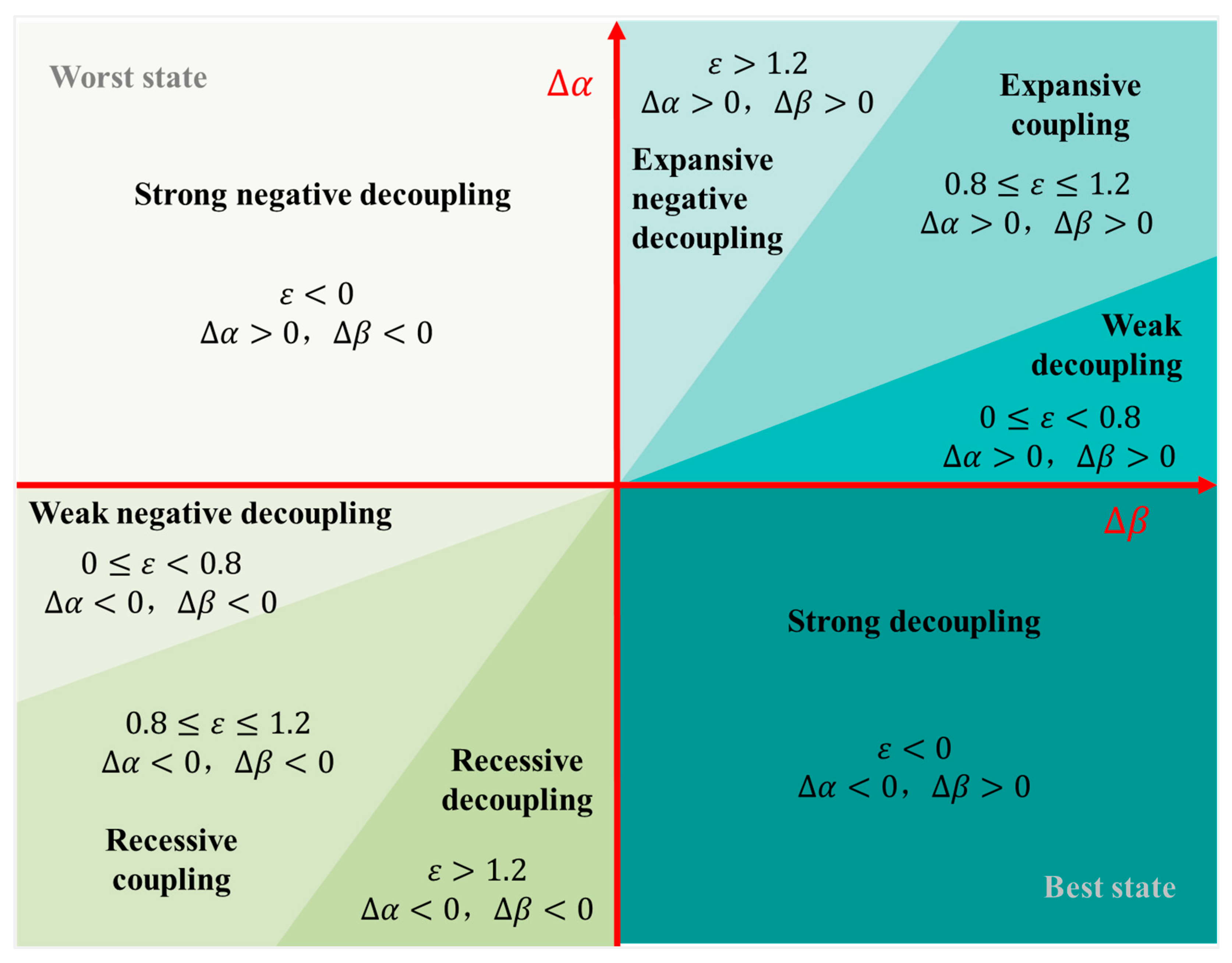
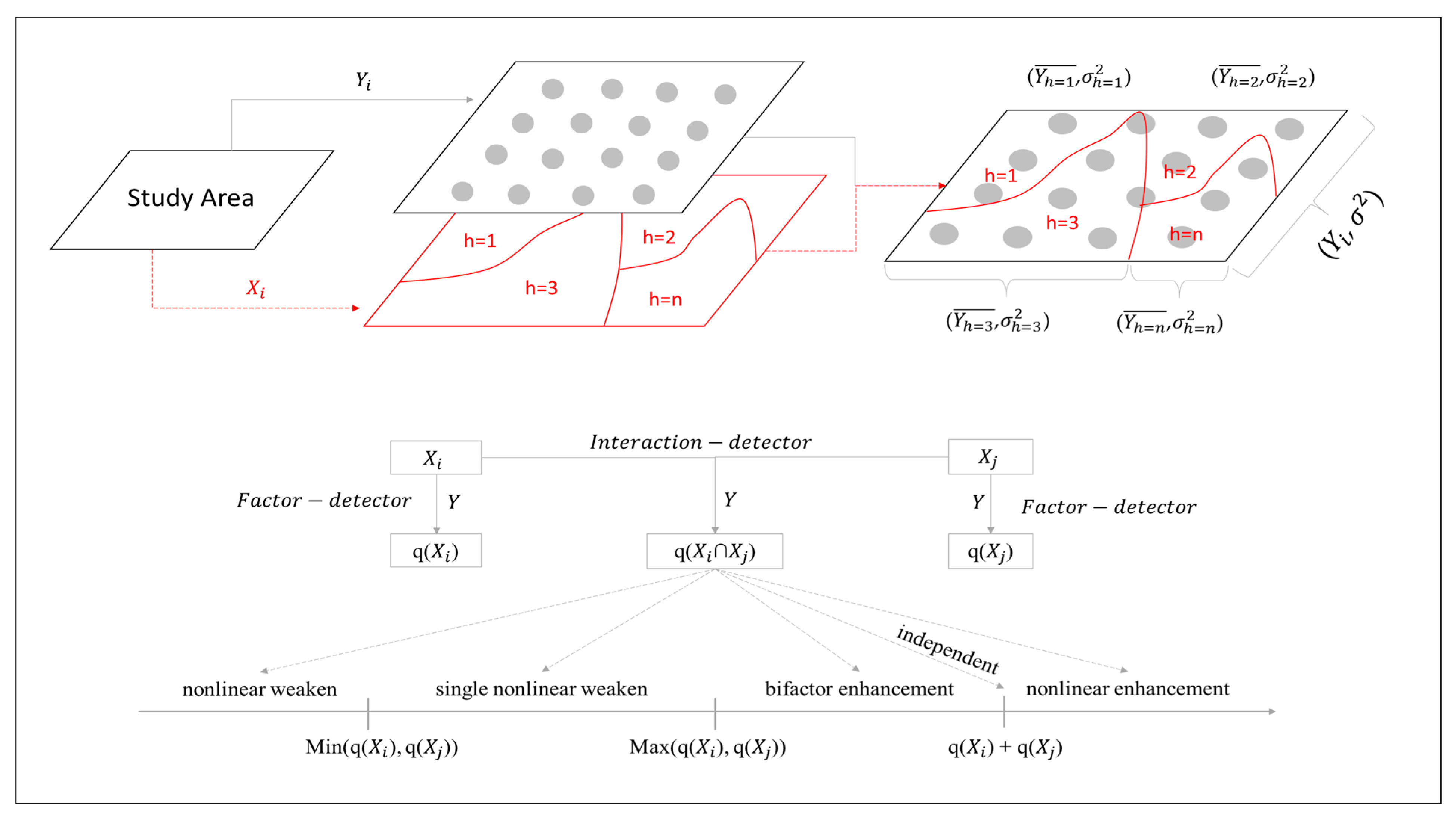
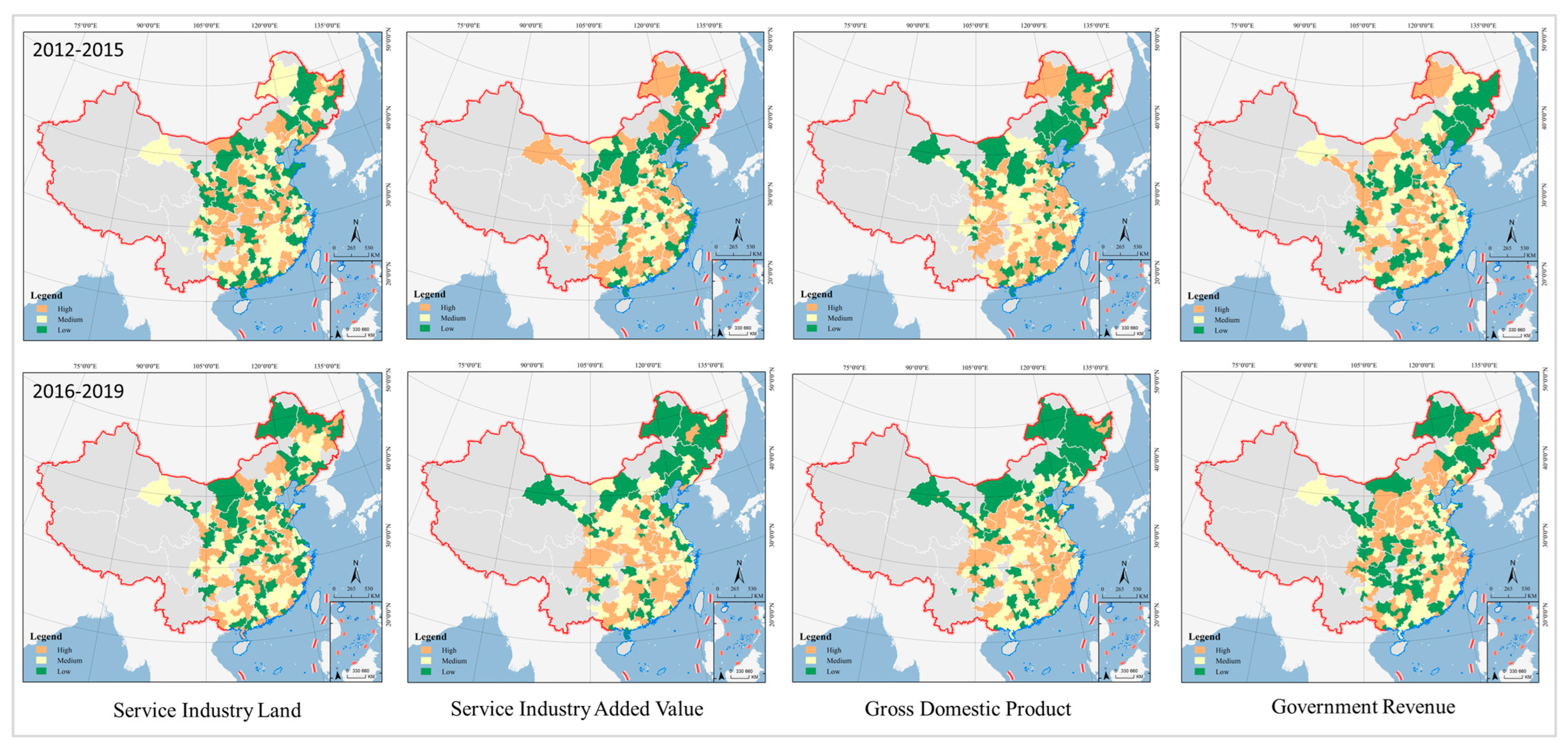
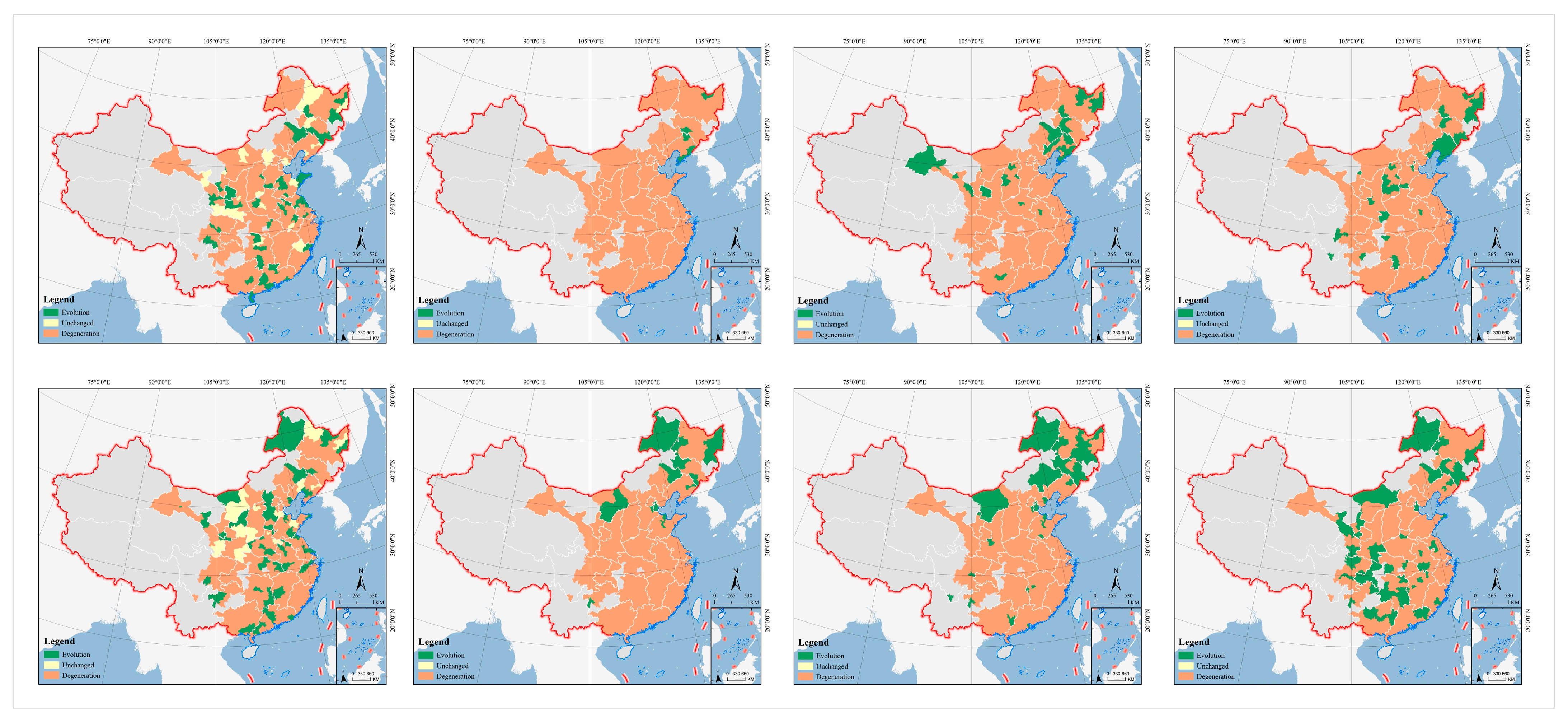

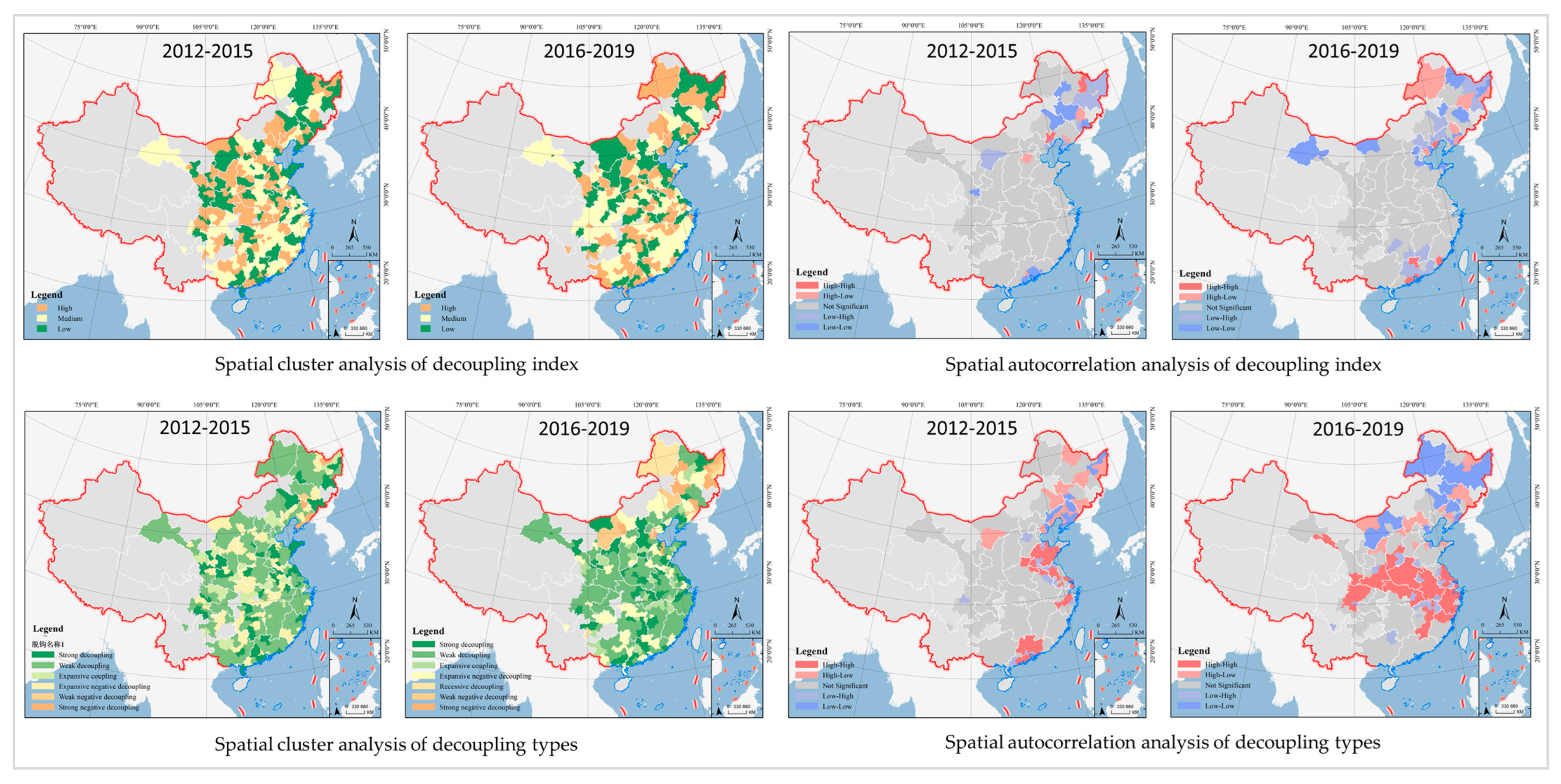

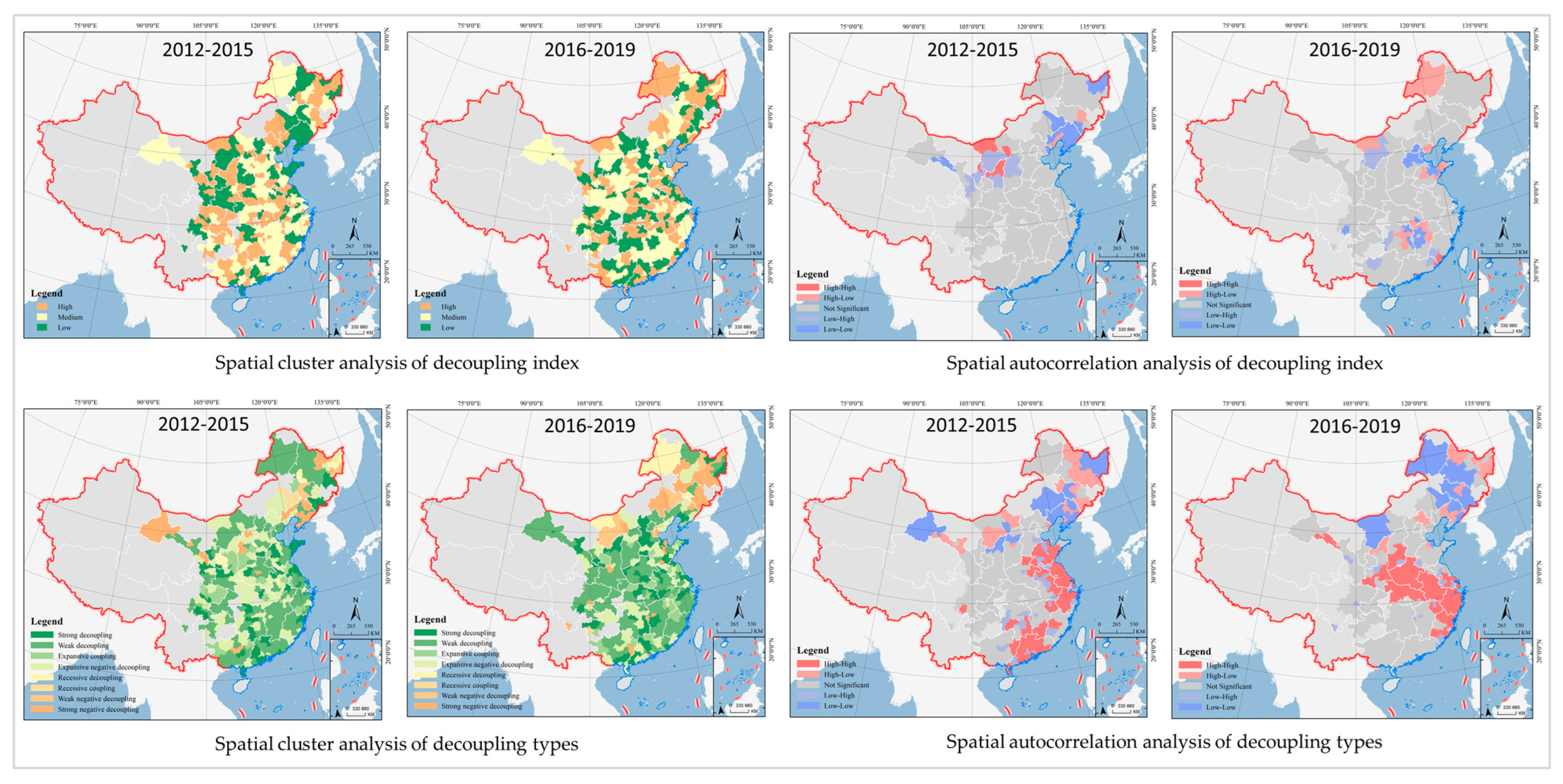
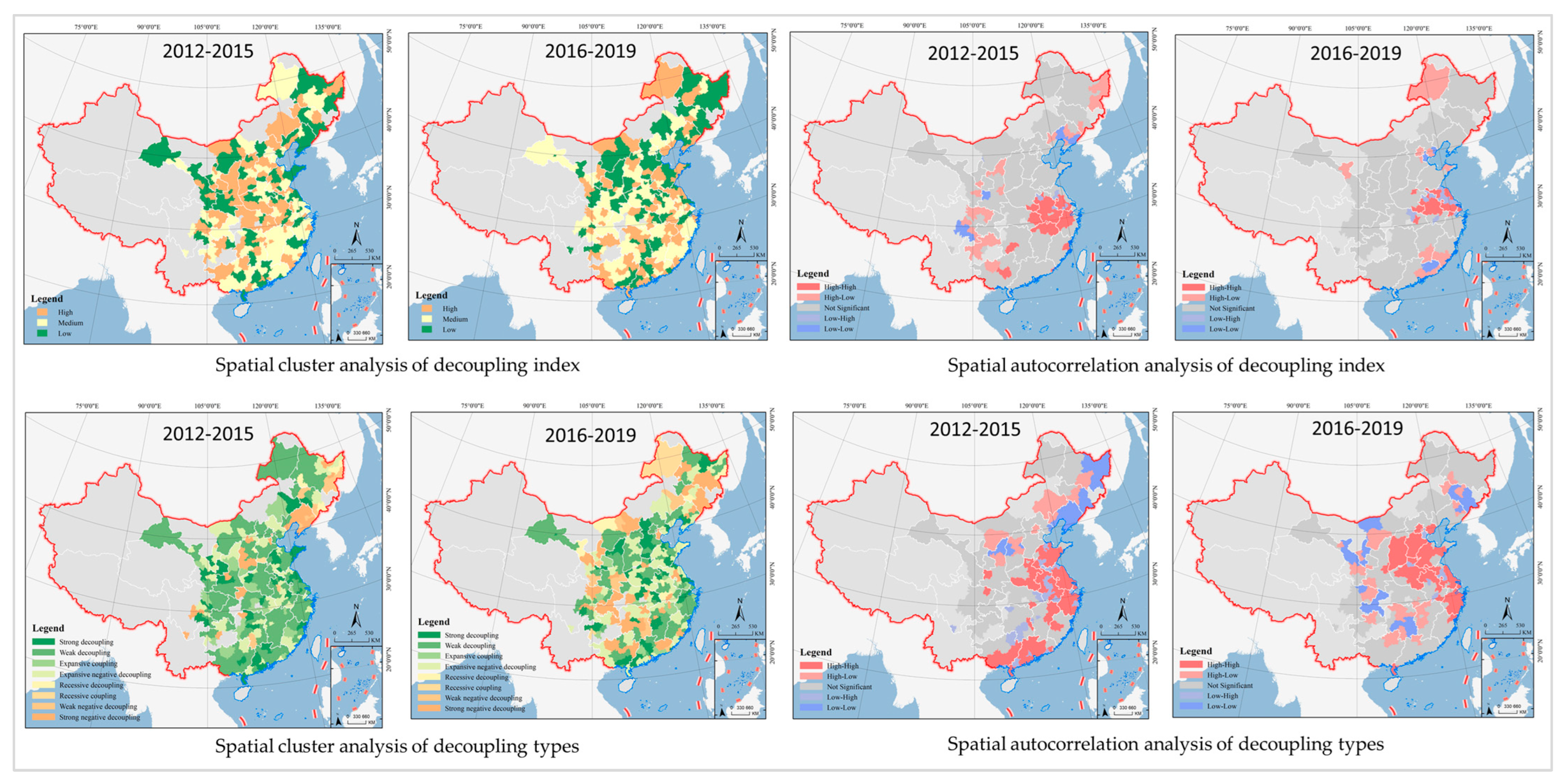

| Year | Indicator | Max | Min | Average | Sum |
|---|---|---|---|---|---|
| 2012 | Service Industry Land | 135.21 | 0.08 | 9.40 | 2566.06 |
| Service Industry Added Value | 214.51 | 0.17 | 8.99 | 2455.51 | |
| Gross Domestic Product | 315.97 | 0.41 | 18.51 | 5052.91 | |
| Government Revenue | 58.72 | 0.03 | 1.97 | 536.73 | |
| 2015 | Service Industry Land | 137.54 | 0.02 | 10.13 | 2766.83 |
| Service Industry Added Value | 294.32 | 0.20 | 13.04 | 3559.61 | |
| Gross Domestic Product | 398.79 | 0.48 | 24.55 | 6700.85 | |
| Government Revenue | 87.74 | 0.04 | 2.87 | 782.23 | |
| 2016 | Service Industry Land | 135.13 | 0.03 | 10.59 | 2890.18 |
| Service Industry Added Value | 310.05 | 0.33 | 13.79 | 3765.80 | |
| Gross Domestic Product | 424.23 | 0.51 | 25.13 | 6860.40 | |
| Government Revenue | 96.44 | 0.05 | 2.88 | 786.72 | |
| 2019 | Service Industry Land | 137.98 | 0.04 | 11.90 | 3247.59 |
| Service Industry Added Value | 428.24 | 0.39 | 18.49 | 5046.58 | |
| Gross Domestic Product | 553.11 | 0.55 | 31.08 | 8484.89 | |
| Government Revenue | 103.86 | 0.03 | 3.19 | 870.38 |
| Max | Min | Average | Coefficient of Variation | Global Moran I | ||
|---|---|---|---|---|---|---|
| 2012–2015 | Service Industry Land | 208.55 | −81.42 | 10.61 | 3.08 | −0.03 (0.111) |
| Service Industry Added Value | 61.38 | −12.93 | 13.59 | 0.58 | 0.15 (0.001) | |
| Gross Domestic Product | 80.87 | −20.27 | 9.07 | 1.12 | 0.20 (0.001) | |
| Government Revenue | 74.77 | −30.15 | 12.81 | 1.17 | 0.22 (0.001) | |
| 2016–2019 | Service Industry Land | 431.38 | −41.91 | 8.04 | 3.83 | −0.22 (0.427) |
| Service Industry Added Value | 189.60 | −23.49 | 13.35 | 1.08 | 0.16 (0.001) | |
| Gross Domestic Product | 189.22 | −25.15 | 8.87 | 1.60 | 0.09 (0.002) | |
| Government Revenue | 68.15 | −44.32 | 4.44 | 2.90 | 0.07 (0.002) | |
| Service Industry Added Value | Gross Domestic Product | Service Industry Added Value | |||||
|---|---|---|---|---|---|---|---|
| 2012–2015 | 2016–2019 | 2012–2015 | 2016–2019 | 2012–2015 | 2016–2019 | ||
| Decoupling | Strong | 51 | 54 | 44 | 51 | 42 | 43 |
| Weak | 138 | 129 | 109 | 109 | 128 | 77 | |
| Recessive | 25 | 21 | 23 | 23 | 16 | 15 | |
| Coupling | Expansive | 54 | 47 | 67 | 54 | 47 | 70 |
| Recessive | 0 | 3 | 6 | 4 | 5 | 8 | |
| Negative Decoupling | Strong | 0 | 0 | 1 | 1 | 1 | 2 |
| Weak | 1 | 6 | 3 | 4 | 9 | 9 | |
| Expansive | 4 | 13 | 20 | 27 | 25 | 49 | |
| Indicator | Code | Cities |
|---|---|---|
| Strong decoupling | 4 | Shijiazhuang, Handan, Baoding, Zhangjiakou, Hengshui, Anshan, Yingkou, Panjin, Hegang, Nantong, Lianyungang, Taizhou-jiangsu, Hangzhou, Jiaxing, Suzhou-anhui, Bozhou, Ji’an, Linyi, Binzhou, Pingdingshan, Jiaozuo, Puyang, Sanmenxia, Zhumadian, Ezhou, Jingmen, Huanggang, Suizhou, Loudi, Guangzhou, Shantou, Maoming, Qingyuan, Yunfu, Qinzhou, Yulin-guangxi, Leshan, Bijie, Yulin-shaanxi, Jiayuguan, Pingliang. |
| Weak decoupling | 3 | Beijing, Chengde, Cangzhou, Datong, Yangquan, Shuozhou, Yuncheng, Linfen, Lvliang, Jinzhou, Fuxin, Chaoyang, Heihe, Shanghai, Wuxi, Changzhou, Wenzhou, Huzhou, Shaoxing, Jinhua, Taizhou-zhejiang, Lishui, Hefei, Huaibei, Lu’an, Xuancheng, Xiamen, Putian, Sanming, Longyan, Ningde, Ganzhou, Yichun-jiangxi, Fuzhou-jiangxi, Wei fang, Kaifeng, Anyang, Hebi, Xuchang, Luohe, Shangqiu, Zhoukou, Huangshi, Shiyan, Yongzhou, Foshan, Nanning, Liuzhou, Guigang, Chengdu, Suining, Yibin, Dazhou, Ya’an, Guiyang, Baoji, Weinan, Yan’an, Hanzhong, Jinchang, Tianshui, Zhangye, Jiuquan. |
| Expansive coupling | 2 | Changzhi, Ningbo, Quzhou, Bengbu, Yingtan, Shangrao, Jingzhou, Huizhou, Shanwei, Nanchong, Anshun, Qingyang. |
| Expansive negative decoupling | 1 | Tangshan, Xingtai, Taiyuan, Jincheng, Jinzhong, Xinzhou, Shenyang, Dalian, Dandong, Tieling, Huludao, Changchun, Daqing, Suihua, Nanjing, Xuzhou, Suzhou-jiangsu, Yancheng, Zhenjiang, Suqian, Zhoushan, Wuhu, Maanshan, Huangshan, Chuzhou, Fuyang, Fuzhou-fujian, Zhangzhou, Nanping, Jiujiang, Jinan, Qingdao, Yantai, Jining, Tai’an, Rizhao, Dezhou, Liaocheng, Heze, Zhengzhou, Luoyang, Nanyang, Xinyang, Wuhan, Xiangyang, Xianning, Changsha, Changde, Zhangjiajie, Yiyang, Shaoguan, Shenzhen, Zhuhai, Jiangmen, Zhanjiang, Zhaoqing, Yangjiang, Dongguan, Chaozhou, Guilin, Beihai, Fangchenggang, Baise, Chongzuo, Zigong, Luzhou, Deyang, Bazhong, Zunyi, Tongchuan, Dingxi, Zhongwei. |
| Recessive decoupling | −1 | Qinhuangdao, Bayannur, Siping, Jixi, Huainan, Tongling, Anqing, Weihai, Wuwei. |
| Recessive coupling | −2 | Hulunbuir, Liupanshui. |
| Weak negative decoupling | −3 | Baotou, Tongliao, Erdos, Benxi, Shuangyashan, Yichun-heilongjiang, Qitaihe, Zhuzhou, Chenzhou, Jieyang, Ankang, Shangluo, Longnan, Guyuan. |
| Strong negative decoupling | −4 | Tianjin, Langfang, Hohhot, Wuhai, Chifeng, Ulanqab, Fushun, Liaoyang, Jilin Liaoyuan, Tonghua, Baishan, Songyuan, Baicheng, Harbin, Qiqihar, Jiamusi, Mudanjiang, Huai’an, Yangzhou, Chizhou, Quanzhou, Nanchang, Jingdezhen, Pingxiang, Xinyu, Zibo, Zaozhuang, Dongying, Xinxiang, Yichang, Xiaogan, Xiangtan, Hengyang, Shaoyang, Yueyang, Huaihua, Meizhou, Heyuan, Zhongshan, Wuzhou, Hezhou, Hechi, Laibin, Chongqing, Panzhihua, Mianyang, Guangyuan, Neijiang, Meishan, Guang’an, Ziyang, Tongren, Xi’an, Xianyang, Lanzhou, Baiyin, Yinchuan, Shizuishan, Wuzhong. |
| Indicator | Code | Best Discretization | q Index | p Value |
|---|---|---|---|---|
| Urban Permanent Population | 10 | 0.09 | 0.00 | |
| Value Added of the Secondary Industry | 8 | 0.13 | 0.00 | |
| Per capita GDP | 7 | 0.06 | 0.02 | |
| Government Financial Expenditure | 6 | 0.04 | 0.05 | |
| International Trade | 4 | 0.03 | 0.04 | |
| Foreign Direct Investment | 10 | 0.07 | 0.02 | |
| Total Retail of Commodities | 9 | 0.09 | 0.00 | |
| Authorized Patents | 10 | 0.07 | 0.03 |
| 0.36 | |||||||
| 0.33 | 0.29 | ||||||
| 0.23 | 0.20 | 0.24 | |||||
| 0.21 | 0.18 | 0.21 | 0.15 | ||||
| 0.37 | 0.31 | 0.31 | 0.21 | 0.17 | |||
| 0.32 | 0.27 | 0.24 | 0.21 | 0.16 | 0.37 | ||
| 0.35 | 0.30 | 0.31 | 0.21 | 0.12 | 0.30 | 0.29 |
Disclaimer/Publisher’s Note: The statements, opinions and data contained in all publications are solely those of the individual author(s) and contributor(s) and not of MDPI and/or the editor(s). MDPI and/or the editor(s) disclaim responsibility for any injury to people or property resulting from any ideas, methods, instructions or products referred to in the content. |
© 2023 by the authors. Licensee MDPI, Basel, Switzerland. This article is an open access article distributed under the terms and conditions of the Creative Commons Attribution (CC BY) license (https://creativecommons.org/licenses/by/4.0/).
Share and Cite
Zhang, P.; Yang, X.; Chen, H.; Zhao, S. Matching Relationship between Urban Service Industry Land Expansion and Economy Growth in China. Land 2023, 12, 1139. https://doi.org/10.3390/land12061139
Zhang P, Yang X, Chen H, Zhao S. Matching Relationship between Urban Service Industry Land Expansion and Economy Growth in China. Land. 2023; 12(6):1139. https://doi.org/10.3390/land12061139
Chicago/Turabian StyleZhang, Ping, Xiaojuan Yang, Hua Chen, and Sidong Zhao. 2023. "Matching Relationship between Urban Service Industry Land Expansion and Economy Growth in China" Land 12, no. 6: 1139. https://doi.org/10.3390/land12061139
APA StyleZhang, P., Yang, X., Chen, H., & Zhao, S. (2023). Matching Relationship between Urban Service Industry Land Expansion and Economy Growth in China. Land, 12(6), 1139. https://doi.org/10.3390/land12061139








